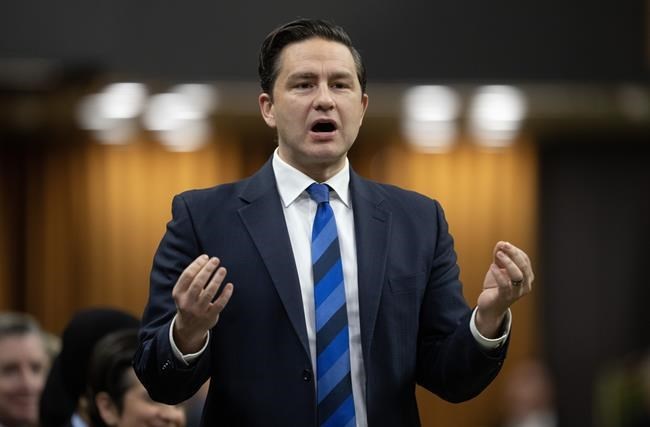OTTAWA — Every week now for more than a month, cabinet ministers have been appearing in front of cameras on Parliament Hill in an effort to convince Canadians that the Liberal government has the housing crisis in hand.
Ever since Prime Minister Justin Trudeau's summer cabinet shuffle, they've been scrambling to be seen making the cost of living a top priority, hoping to catch up to the runaway Conservatives on the issue of affordability.
Like clockwork, Housing Minister Sean Fraser appeared Tuesday alongside Deputy Prime Minister Chrystia Freeland, this time to announce millions in spending to build or upgrade thousands of co-operative homes.
The Conservatives, meanwhile, have been racking up millions of clicks, views and shares with a slick 15-minute explainer video, complete with graphs, news segments and narration from none other than leader Pierre Poilievre.
Welcome to the main event of Canadian politics: the battle to become the party voters can trust to confront one of the country's most pressing issues.
Poilievre's video, in which he lays blame for the housing shortage squarely on Trudeau's shoulders, is only his latest effort to use his massive social media following to speak directly to potential voters — particularly younger ones.
The two strategies also illustrate opposing outlooks on the mainstream media, a group Poilievre and his Conservative party — to say nothing of their supporters — have long cultivated as a useful political punching bag.
"It shows what modern political communications is like," said Mobilize Media Group president Jeff Ballingall. "It's great to see that Pierre's team is reflecting modern communications in media consumption."
Poilievre's latest video lays out the Conservative case "in a way that's compelling," said Ballingall, the social media architect behind Ontario Proud and Canada Proud, two accounts dedicated to attacking Trudeau and the Liberals.
Cole Hogan, who worked on digital ad campaigns for provincial conservatives like Ontario Premier Doug Ford and former Alberta premier Jason Kenney, said he would normally advise against making a video like Poilievre's.
Not only is it a time-consuming endeavour in a field that moves at a lightning-fast pace, Hogan said, but existing wisdom says short, snappy content is usually more effective online.
Poilievre, however, is nothing if not unconventional, he added: "It's hard to imagine this coming from anybody else."
Social media's other advantage is that it provides detailed intelligence on who is watching on which platform and from where — crucial information in politics, where "data is everything," Ballingall said.
"From there you can distil a lot of your messaging later on."
While Conservatives are lauding Poilievre's latest endeavour as a success, Fraser and other Liberals accuse him of exploiting the anxieties of Canadians without offering much in the way of practical solutions.
Poilievre is a "wolf in sheep's clothing" who is "pretending to understand the challenges that people are living with, but insisting that he's not going to advance the solutions that are actually going to help them, "Fraser said.
"Comparing one plan to another, it's clear: we're going to build more homes and more homes that people can actually afford."
Near the end of the video — Poilievre calls a documentary — he outlines a four-point housing plan that includes familiar pledges, like selling off federal lands and making the construction of more homes a condition of funding for cities.
It comes at a time when the Conservative leader is keen to demonstrate that he has ideas for dealing with the challenges Canadians are concerned about. A video that lives permanently online also increases the chance that more and more eyeballs could eventually find it.
Conservative strategist Jamie Ellerton said Poilievre's video is about "building his credibility and building a sense of trust himself and Canadians more broadly."
Catching up to the Liberals in the digital realm has been a problem for the party since before Trudeau was even elected eight years ago, Ellerton added.
"It's undeniable that in 2015, the Liberal party had an advantage in the digital realm and were much further ahead," Ellerton said. "But the Conservatives, under Pierre Poilievre's leadership, have started to close that gap."
As a federal leader, Poilievre is more of a "digital native" who is helping the Conservatives catch up with what sort of content and messages work well online, he added.
"Pierre's just bringing a new generation of insight to the leader's office."
On substance, Poilievre's video earns a grade of B-plus, said Christopher Ragan, a professor of economics at McGill University in Montreal.
In spots, the Conservative leader is "playing a little fast and loose" with details like how the Bank of Canada works, but overall, "it's actually quite a good video," Ragan said.
"For the most part, the story he's telling about house prices ... declining housing affordability, government spending, interest rates — I think for the most part, he is right."
For their part, the Liberals say they aren't worried.
"Innovative digital campaigns in the lead-up to and during the 2015, 2019, and 2021 elections" were an important part of how Trudeau connected with Canadians, spokesman Parker Lund said in a statement.
"The same will be the case for the next election, whenever it may arise."
This report by The Canadian Press was first published Dec. 5, 2023.
— With files from Nojoud Al Mallees in Ottawa
Stephanie Taylor, The Canadian Press




